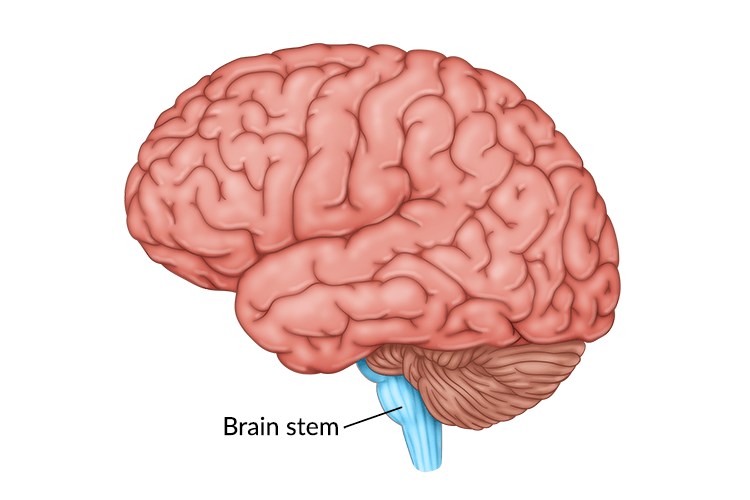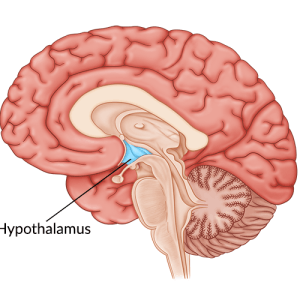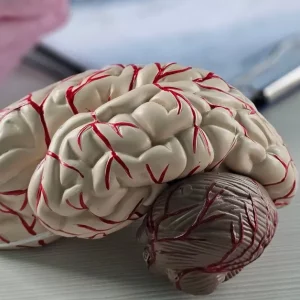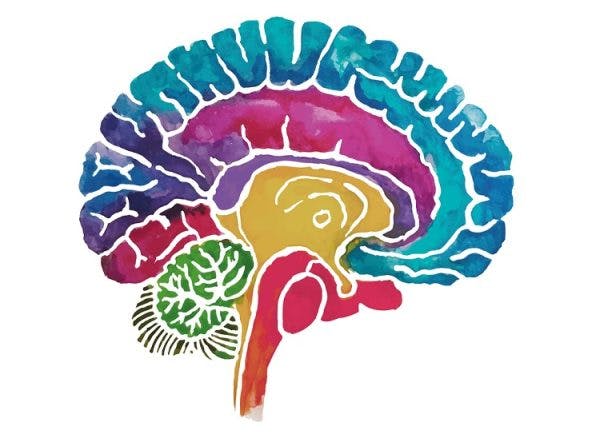When brain stem damage occurs, important basic life functions, like breathing, are impacted. Fortunately, it is often possible for a person with a brain stem injury to recover through rehabilitation.
This article will cover everything you need to know about brain stem damage and how the recovery process works. Use the following links to jump ahead to certain sections:
What Does the Brain Stem Do?
The brain stem is located at the base of the skull directly above the spinal cord. It connects the brain and spinal cord, which transports messages via neural pathways throughout the body. The brain stem is also responsible for critical functions that keep you alive and aware of your surroundings, making it one of the most important areas of the brain.
The brain stem is comprised of three distinct sections, which each section contributing to different functions:
- Midbrain. At the top of the brain stem rests the midbrain. This structure plays a large role in muscle movement, particularly eye movement.
- Pons. Below the midbrain lies the pons. The pons acts as a bridge between the cerebellum and spinal cord and helps control your balance, among other things.
- Medulla. Finally, at the bottom of the brain stem is the medulla. The medulla oversees essential life functions, such as breathing, heart rate, and swallowing.
Because the brain stem is the link between the spinal cord and the rest of the brain, damage to the brain stem can also affect other functions besides the ones listed above.
Effects of Brain Stem Damage
Brain stem damage is rare. Most injuries to the brain stem are the result of swelling in other areas of the brain as swelling forces the brain stem against the skull. You can also suffer brain stem damage after a brain stem stroke or diffuse axonal injury that tears the brain cells in the midbrain, pons, or medulla.
Regardless of how brain stem damage occurs, there are various effects associated with this type of brain injury. Many of them affect basic life functions. Because every brain injury is different, brain stem injury survivors may experiences some, all, or none of the possible effects.
Here are some of the most common effects of brain stem damage:
1. Coma

The brain stem houses a network of neurons called the reticular activating system, which is responsible for states of consciousness and your ability to wake up. When the brain stem sustains damage, the reticular activating system can be affected and result in a coma.
Most comas after brain injury will last until the swelling goes down. After that, a person will usually pass through three stages of consciousness before finally becoming alert.
These stages are:
- Vegetative state. Eyes may open and shut but the person cannot respond in a meaningful way, like squeezing your hand.
- Minimally conscious state. Person can respond by blinking or smiling but falls in and out of consciousness.
- Confusional state. Person is awake and aware but does not have full control over their behavior.
The faster the person progresses through these stages, the higher their chances of making a full recovery will be. For example, patients who reach a minimally conscious state within three months have a high likelihood of regaining full consciousness compared to those who are still in a vegetative state after 12 months.
2. Locked-In Syndrome
One of the most severe effects that can occur after damage to the brain stem is locked-in syndrome. This condition causes full paralysis of the body except for the eyes.
This is a motor issue, meaning it only affects a person’s ability to move. Everything else about the individual — including their ability to think, reason, and hear everything going on around them — remains functional.
Because locked-in syndrome is a serious condition, most people do not regain movement, although some have.
Supportive care is often the best option for survivors with locked-in syndrome. There are also computer programs that track eye movement so that the individual can communicate using specific eye movements.
3. Swallowing Problems
The medulla (the bottom section of the brain stem) controls various basic life functions including swallowing. When this section of the brain stem sustains damage, it can cause swallowing problems such as dysphagia.
While the brain stem is not the only part of the brain that contributes to swallowing, it plays a significant role in automatic swallowing and the gag reflex. Because brain stem damage can impair this automatic reflex, survivors are at a greater risk of choking on their own saliva.
Fortunately, you can treat most swallowing problems with swallowing exercises for dysphagia. A speech therapist is the most qualified professional to help you overcome dysphagia, and they are often part of the medical team treating a traumatic brain injury.
4. Respiratory Problems
The medulla also helps control breathing by sensing the level of carbon dioxide (CO2) in the blood and adjusting your respiratory rate in response.
However, a damaged medulla cannot detect how much CO2 is in the blood. As a result, it doesn’t know how much air the body still needs. This can cause breathing problems for brain stem injury survivors.
The most common respiratory problems after brain stem damage include:
- Hyperventilation: breathing too much too fast
- Hypoventilation: breathing too little too slow
- Apneustic breathing: problems exhaling air
- Apnea: lack of breathing
When breathing issues are severe, the survivor requires a ventilator until respiratory function returns to normal. There are also some medications that help regulate breathing patterns and stimulate brain stem activity.
5. Motor Difficulties
Although motor difficulties are not explicitly associated with brain stem damage, it’s worth mentioning as brain stem damage is often caused by an injury elsewhere in the brain.
For example, directly connected to the pons is the cerebellum, which controls balance and coordination. When the cerebellum sustains damage, it can impair an individual’s balance, resulting in a condition called ataxia.
While ataxia is associated with cerebellar damage, it can often coincide with brain stem damage due to close proximity.
Furthermore, movement is a brain-wide process. While the cerebellum controls balance, there are many other areas of the brain that contribute to movement, such as the motor cortex. Therefore, if more than the brain stem was impacted by injury, motor issues can occur.
Treatment for Brain Stem Damage

Treatment for brain stem damage generally occurs in two phases. First, doctors address immediate, urgent concerns around the initial brain injury, such as relieving pressure within the brain through surgery.
Once the brain and body have been medically stabilized, the survivor can participate in rehabilitation. This involves addressing any secondary effects that the survivor sustained.
The effects of brain stem damage arise from damage to nerve cells within the brain stem. While damaged nerve cells cannot be recovered, the brain is capable of rewiring itself so that other, healthy nerve cells can take on new functions to compensate for the damage.
This process is called neuroplasticity, and it allows the brain to create new neural pathways and re-learn lost functions. Even the most basic life functions such as breathing and swallowing have the potential to be relearned through neuroplasticity — but it requires rehabilitation.
While some neuroplasticity occurs spontaneously (without effort), this is often limited and slows down after the initial injury. In order to keep neuroplasticity activated, survivors must engage in various therapies to help stimulate the brain and engage neuroplasticity.
Rehabilitation for Brain Stem Injury
Neuroplasticity is activated by “massed practice,” or high repetition of a specific task. Survivors can work towards improving specific functions by practicing that task on a repetitive and consistent basis.
Here are some helpful types of therapies that brain stem injury survivors may participate in during rehabilitation:
Speech Therapy
If damage to the brain stem has impaired your ability to swallow, a Speech-Language Pathologist, or speech therapist, is the best expert to help.
A Speech-Language Pathologist can assess your needs and determine if you would benefit from a feeding tube, different food textures, or swallowing exercises. Often, even if an individual requires a feeding tube, they may be able to rehabilitate oral muscles through rehabilitation by practicing safe swallowing exercises if they can partially move their mouth or tongue.
Speech-Language Pathologists can also help with any language or cognitive issues that may occur after a brain injury.
Physical Therapy
If movement has been affected by a brain injury, physical therapy is an excellent way to retrain motor skills.
Physical therapy yields the best results when survivors both practice physical therapy exercises alongside their therapist and follow a consistent regimen at home. This helps provide the brain with the constant stimulation it needs to rewire itself.
The more you activate your muscles through physical therapy, the more skills you can hope to recover.
Individuals with paralysis, such as those with locked-in syndrome, require a caregiver or therapist to move their limbs through full range-of-motion to help promote flexibility and blood flow. Passive movement can also help spark neuroplasticity.
Want 25 pages of TBI recovery exercises in PDF form? Click here to download our free TBI Rehab Exercise ebook now (link opens a pop up for uninterrupted reading)
Occupational Therapy
While physical therapy is concerned with teaching you how to rebuild your physical strength and movement patterns, occupational therapy looks at the specific skills you need to regain independence.
During an occupational therapy session, your therapist will guide you through many important activities to improve your independence after brain stem damage.
Continuing Rehabilitation at Home
To ensure the best recovery from brain stem damage, be sure to practice your rehab exercises every day between visits with your therapist.
For example, if you struggle with swallowing problems, your speech therapist can send you home with a sheet of exercises that are safe for you to practice.
If you struggle with movement, there are also home therapy devices, such as FitMi, which walk you through physical therapy exercises in a fun and engaging manner. Because FitMi is interactive, it can help you stay motivated in a way that written sheets of exercises do not.
However, with rehabilitation, the key to recovery is repetition and consistency. Practicing your exercises daily will keep your brain stimulated and maximize your chances of recovery from brain stem damage.
Understanding Brain Stem Damage Recovery
Damage to the brain stem can impair basic life functions and some individuals will require intensive support. Fortunately, many individuals can work towards recovery through a consistent rehab program that targets their unique needs.
As several severe brain injury recovery stories show, the brain is a remarkably adaptable organ, and with the right treatment and enough perseverance, you might be able to make a remarkable recovery.










